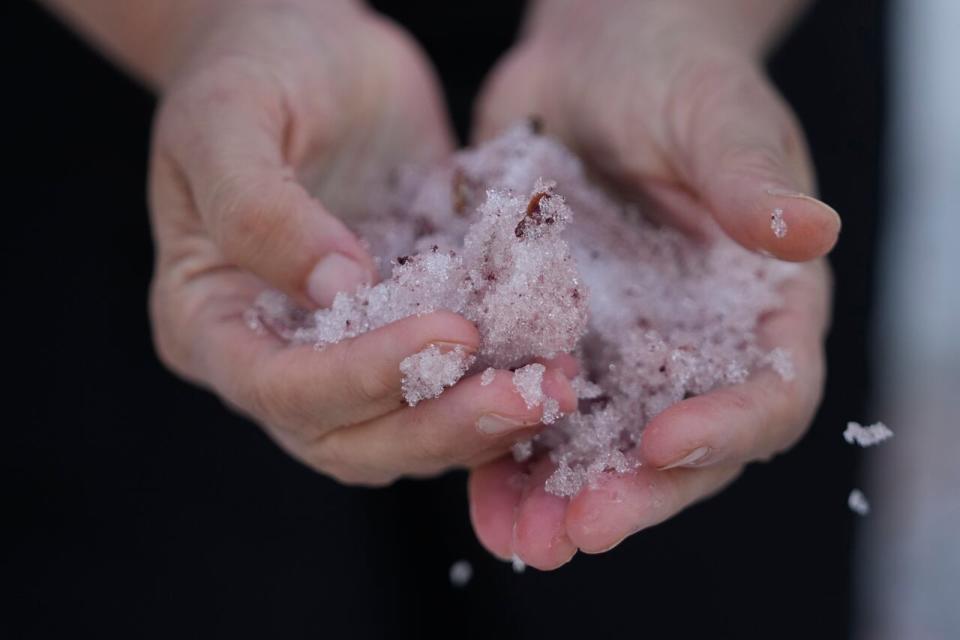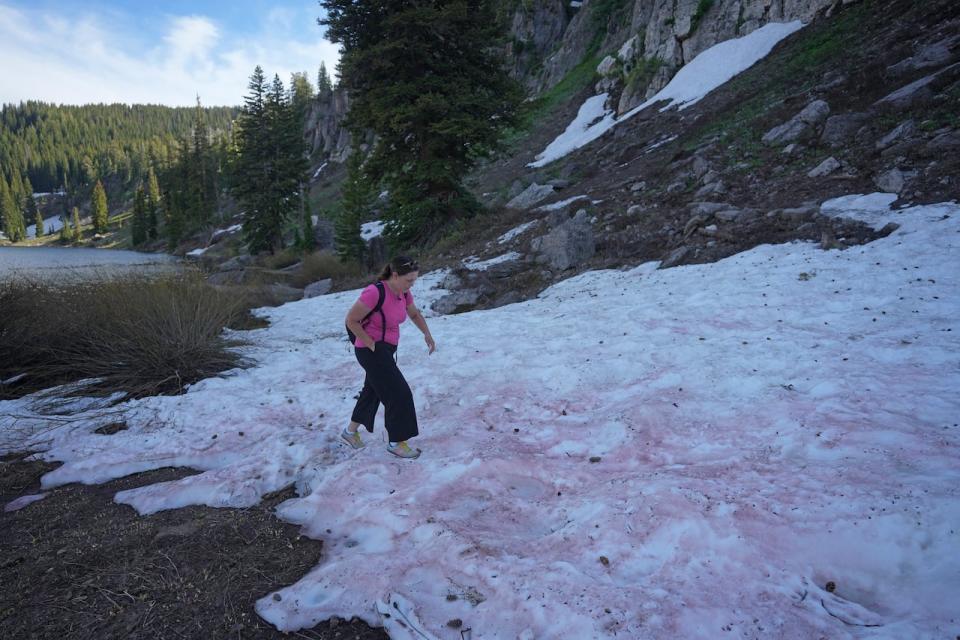The Rocky Mountains conjure up images of jagged gray and white peaks. But within the upper reaches of the harsh mountain landscape, flowers are often rose-colored.
Watermelon snow, also known as glacial blood, is caused by algae that turn the snow a deep red shade.
The algae flourish during the summer, forming on the snowfields that remain on glaciers, frozen lakes, rugged peaks and icy valleys in the upper reaches of the mountains.
The darker the snow, the faster it melts — and new research sheds light on the threat snow algae poses to shrinking glaciers across northwestern North America.
Snow algae researcher Lynne Quarmby, lead author of a study recently published in Science Advances, said the findings are a warning about our changing climate.
“We don’t need any more canaries in this mine, but they are another canary in the mine,” said Quarmby, a professor of molecular biology and biochemistry at Simon Fraser University.
“The loss of algae is a sign that we are losing snow and glaciers, and these will affect our lives and the lives of many other organisms.”
The study mapped the presence of snow algae on mountains in Alberta, British Columbia and northern Canada along with Alaska, Idaho, Montana and Washington state.
The researchers developed a machine learning program to analyze more than 6,100 satellite images of glaciers captured between 2019 and 2022.
The study found that red algae blooms contribute to glacial melting. However, global warming poses a much greater threat to mountain glaciers and the incredibly complex microscopic ecosystems that allow snow algae to colonize them.
“We set out in this study to look at the impact of climate change on these blooms and how they affect climate change,” said Quarmby.
“And I think the impact of climate change on them is clear and dramatic.”
Red survival mechanism
Supported by a vast ecosystem of bacteria and fungi, snow algae thrive when water and nutrients are released from melting snow.
The phenomenon is the result of blooms of Chlamydomonas nivalis, which thrives at temperatures close to freezing. Dependent on photosynthesis, the blooms act as carbon sinks, absorbing carbon dioxide from the atmosphere.
Although closely related to the blue-green algae often seen in lakes, snow algae has a red hue that allows it to survive in harsh mountain environments.
“The red color means that when they bloom they give this snow a red color,” she said. “It gets called watermelon snow because it’s like the color of watermelon.”


A hiker holds a handful of watermelon snow, caused by snow algae. A new study examines the presence of flowers on glaciers across North America. (Rick Bowmer/Associated Press)
The blooms darken the surface of summer snowfields, making them less reflective against the sun, causing the snowpack and ice below the bloom to melt faster.
The red pigment creates a “positive feedback loop,” Quarmby said: the algae feed on water released by the extra heat.
The darker pigment also acts as a “shadow shade,” protecting the algae from being damaged by the sun, she said.
Quarmby and fellow SFU researcher Casey Engstrom set out to draw a large-scale map of the microscopic ecosystems.
They found that between 2019 and 2022, red snow covered more than 4,214 square kilometers of glacier landscape, equivalent to 4.5 percent of the total study area.
The researchers estimate that the red snow deposited an average of three centimeters of snowmelt per season.
“The influence of [the algae] It’s recognizable, it’s real,” Quarmby said.
Snow algae were found on 4,552 out of 8,700 glaciers studied.
Some had only a patch but many had large blooms. For example, in 2020, algae covered nearly two-thirds of the surface area of Alberta’s Bow Glacier in the Wapta Icefield.
Glaciers along the Pacific Northwest coast are usually full of algae but during the 2020 heat dome, the ice melted so quickly, the blooms didn’t have a chance to develop.
Quarmby said as snow begins to disappear amid rising temperatures, so will the algae. It will mean the loss of a valuable ecosystem that scientists are only beginning to understand.
“For me, it’s one more sad thing that we’re losing it. If you see these things under the microscope, they’re amazing. Even if you just see them on the landscape, it’s amazing.”


A hiker walks across pink-black snow at Tony Grove Lake on Wednesday, June 28, 2023, near Logan, Utah. (Rick Bowmer/Associated Press)
Scott Hotaling, an ecologist from Utah State University who studies biodiversity in cold and high-altitude environments, said the scope of the research is impressive. Hotaling was not involved in the SFU study.
By relying on satellite images, the researchers were able to study glaciers previously inaccessible to science and collect data on a massive scale, he said.
Hotaling said the work provides an important baseline for the impact of snow algae on a retreating glacier.
“As the snowpack shrinks, these flowers will become more concentrated and smaller and smaller.
“The melting characteristics of those snow algae are going to become more important. When there’s only a small amount of snow left, anything that affects that becomes more important.”